Julia Fish: Illuminations of Partial Recall
by Judith Russi Kirshner
This essay was written in March 2020 after the exhibition Julia Fish:bound by spectrum closed at the DePaul Art Museum.
Now, six months later, our lives have been dramatically altered and constrained. Wracked by devastating losses from the COVID-19 pandemic, the challenges posed by current political realities and perilous climate changes, many of us, limited to virtual screens, have sheltered in place. During days of self-quarantine, our surroundings have become spaces of confinement and refuge. Julia Fish’s attentive representation of domestic realities and infinite, even metaphysical transformations become imaginative models for how we might experience this elongated moment.
Paradoxically, looking at these artworks, based on spectral precision and poetic revision, we are compelled to consider existence beyond the frames. Fish’s gorgeous thresholds, always prescient, are even more urgent.
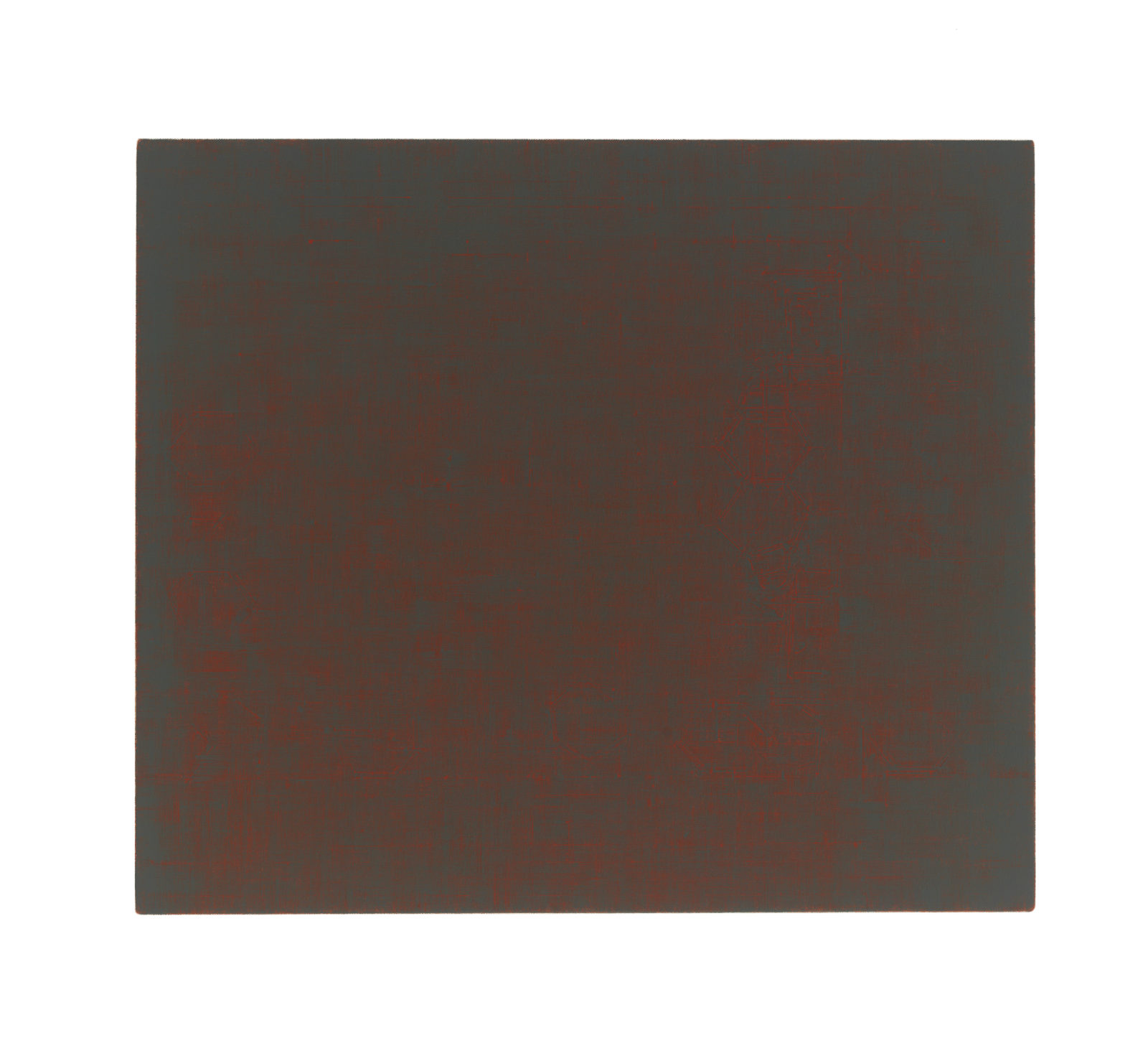
Julia Fish, Lumine IV : asunder [ twilight ], 2017. Oil on canvas. 23 x 27 inches (58.42 x 68.58 cm).
Courtesy of Rhona Hoffman Gallery. Photo: Tom Van Eynde
The exhibition of twelve paintings and fourteen works on paper, which closed at the DePaul Art Museum earlier this year, surveyed a decade of artist Julia Fish’s mesmerizing interpretations of the architectural plans and details of her 1922 Chicago storefront home. Fish’s virtuoso abstractions of light and color enabled viewers to experience the artist’s creativity, adapting and revising the imagery and allegorical connotations of the idea of thresholds—images of interstices, both literal and metaphorical intervals, that grew out of the artist’s earlier paintings of floorplans and, read from the lower edge of each canvas to the top, may be construed as tracking her passages over time.
Featuring six paintings depicting thresholds from the artist’s point of view, the canvases contained within the first gallery of the museum appeared to look down at the doorsills between rooms. Each measuring approximately 2 by 4 feet, these compositions in the Threshold series (2009–14) were proportional to the actual dimensions of its referent. Initially disorienting, paintings such as Threshold, SouthWest – Two [spectrum:green] (2009–10) snap up to face us. Because the hexagonal tile pattern at the top of Threshold, North [spectrum:blue] (2009–10), which abuts the delicately detailed, horizontal planks of a wooden floor, is recognizable, we understand it as being beneath us. The image gradually settles, inviting us to contemplate the dense layers of intersecting brushstrokes—oriented horizontally for primary colors, and vertically for their complementary hue. At the right and left sides of each work, Fish limns the cross sections of the door jambs in their actual position. Read as negative spaces, these shapes also suggest frames, brackets, or jagged profiles. Such ambiguous perceptual effects recall the two faces/one vase illusion, in which the outlines of both sides of a vase, as figure, can be equally perceived as facial profiles, when the space between them becomes ground. Each pair of these sidebars is painted the color of the respective work’s title; for example, the cross-sectional door jambs of Threshold, SouthEast – One [spectrum:yellow] are lemon colored. Across each of these works, Fish’s palette is muted: whitened green, light blue, blanched orange. In Threshold, SouthWest – One [spectrum:red] (2011–12), the titular red registers as dusty rose. Internalizing a situational context, Fish assigns her colors based on the location and orientation of each threshold, from the eastern entrance of her home to its western perimeter. These directional notations are assigned primary and secondary hues as complementary pairs (red/green; blue/orange; yellow/violet). In this particular group of Threshold paintings, north is labeled blue; one painting of southwest is green; the other version, red; and southeast is orange with grey. The only outlier in this largely sunlit series is the plum tonality and vertical orientation of Threshold, NorthWest – One [spectrum:violet with grey] (2010–14); what we recognize here is less legible as planks than an impenetrable nocturnal screen.
“Brushed on, rubbed out, and reiterated, the intricately colored layers of Fish’s optical transformations also engender perceptual afterimages of what lies beyond the picture’s edge.”
Fish’s remarkable ability to arrest the fugitive variety of the natural light that illuminates her interiors—the sun fluctuating over the course of hours, days, and seasons—is a notable aspect of her work. More overt illustrations of her preoccupation with the properties of light, in this case artificial, can be seen in the gouache-on-paper Study for Lumine 11 (2009), which pictures the double globes of a simple suspended ceiling fixture. It is this same ceiling that becomes the crimson surface for Lumine IV:asunder [twilight] (2017), a 23 x 27 inch abstraction. In this nearly monochrome canvas, Fish outlines in red the six barely detectable facets of the sleeping-room lights she imagines over her head at night, their shapes echoing that of North‘s threshold tiles.
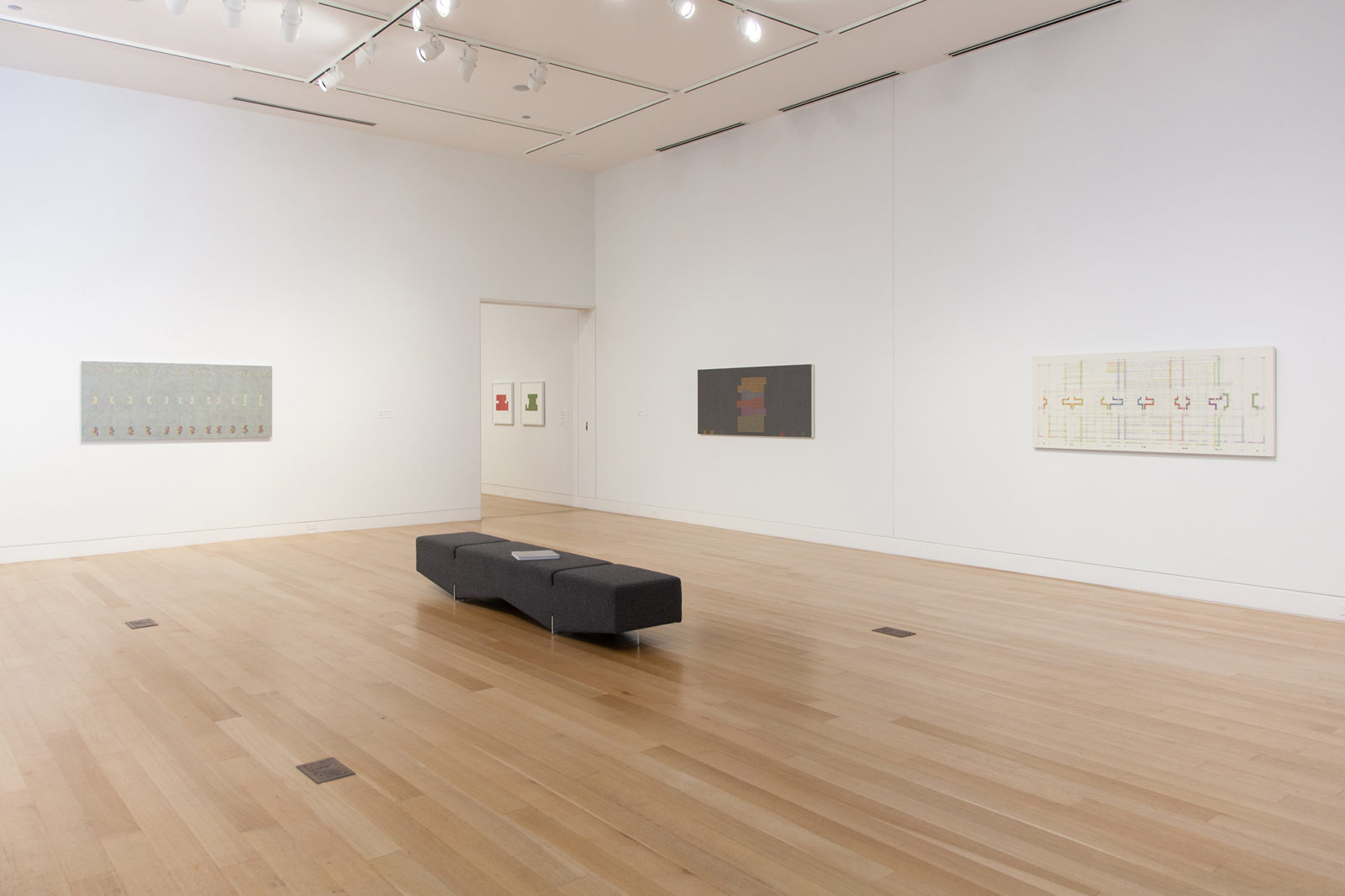
Brushed on, rubbed out, and reiterated, the intricately colored layers of Fish’s optical transformations also engender perceptual afterimages of what lies beyond the picture’s edge. By concentrating on particular architectural fragments, the artist implies a larger whole—not only the home, but what exists beyond its architecture. The Thresholds constitute a powerful example of how Fish manipulates figure-ground relationships without ever resorting to a figure, along with her subjective—not to mention eccentric—figure-ground dynamics. At first glance, the interior shape in Threshold, SouthWest – One [spectrum:red] suggests a column and capital; upon closer inspection, however, delicate strokes at the vertical edges between each floor plank proliferate and seem woven, like threads of silk. These imposing forms also evoke torsos; from this perspective, the band across the center of Threshold, SouthEast – One [spectrum:yellow] operates as a belt.
There is a productive contradiction between how attentively Fish records familiar domestic details such as the faint diagonals of linoleum tiles at the lower half of Threshold, SouthWest – Two[spectrum:green] and the breadth of her art-historical repertoire. She retains a profound connection to the unique atmospheric conditions of her home state of Oregon while discovering abundant reflections in the floor of Bologna’s Basilica of San Petronio, where the meridian lines track the sun’s passage. Alert to modernist history, Fish has acknowledged the serial geometry and rigorous thinking of Minimalists like Sol LeWitt. Her meticulous practice is also informed by her study of the psychic effects of color, referencing the chromatic gradations and repetitive marks of Agnes Martin’s meditative paintings. While the structure and annotation of musical scores, combined with the specific language of architectural plans, are purposeful analogues of Fish’s practice, the faded tints of her favorite postcard reproductions remind her of time’s passage.
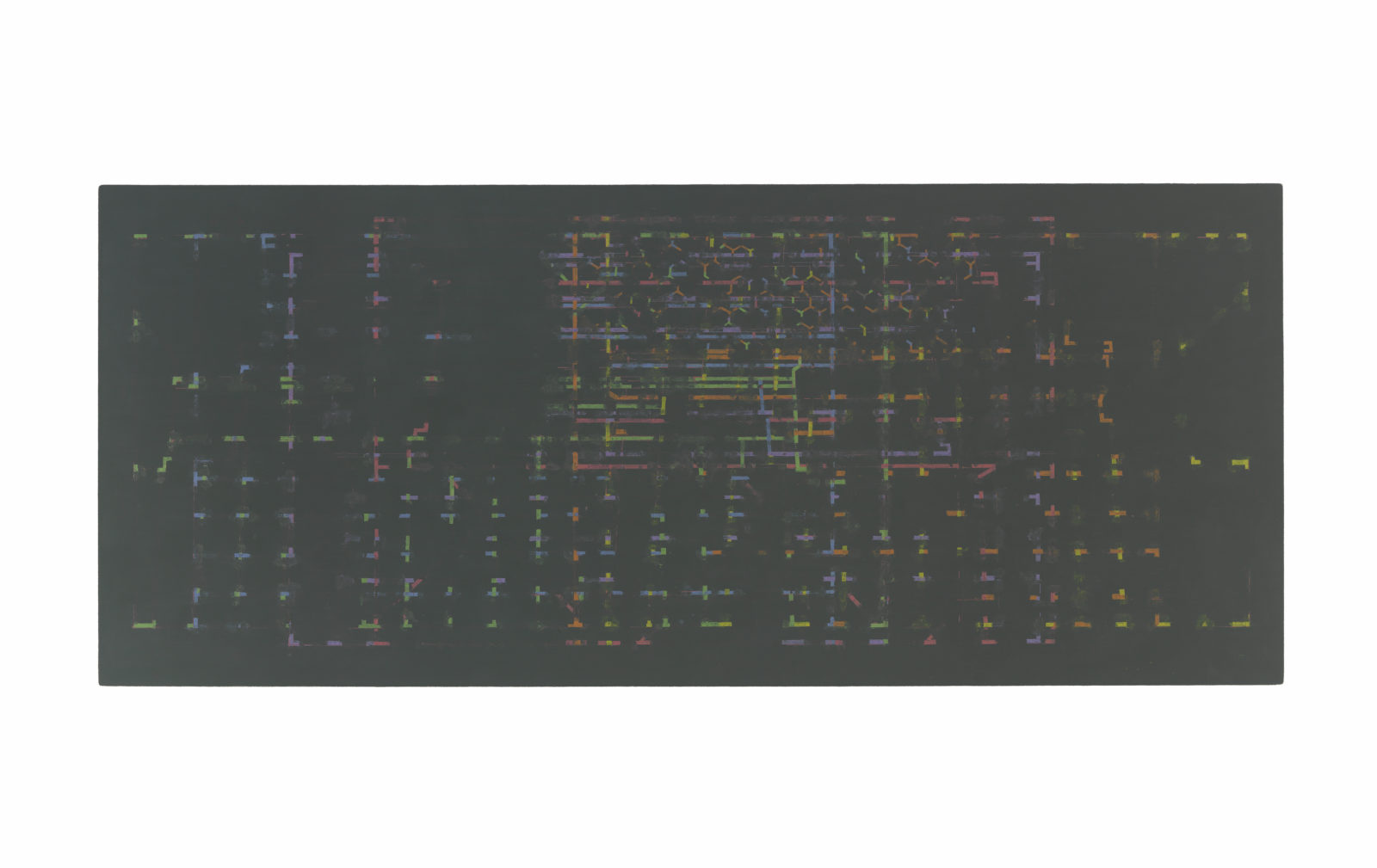
30 x 70 inches (76.20 x 177.80 cm). Courtesy of David Nolan Gallery, New York. Photo: Tom Van Eynde.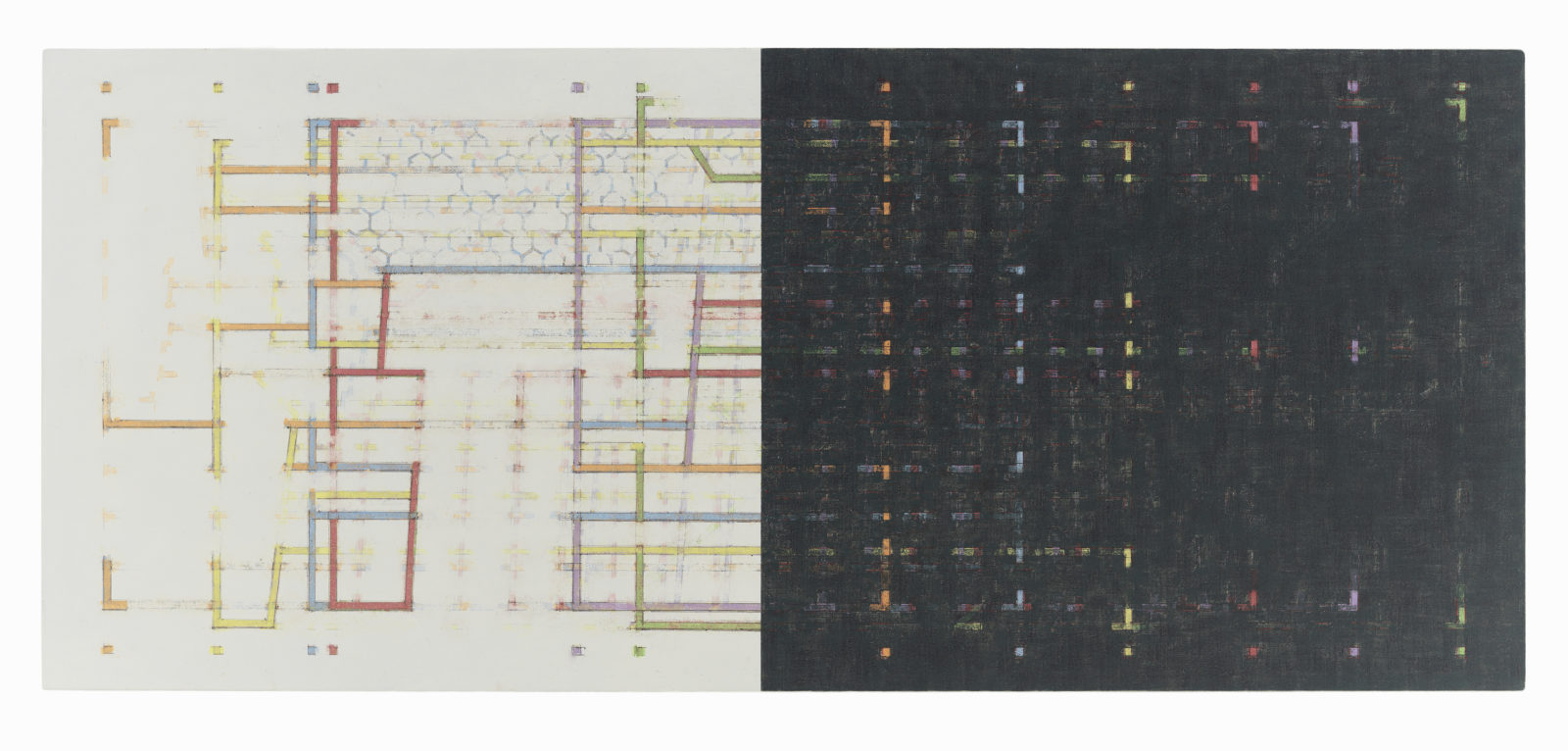
A very different composition and figure-ground relationship is at work in the five Matrix paintings (2014–19), which constitute the second part of the exhibition. Still constant throughout the works is the relational interplay of the six-color scheme Fish assigns in the Thresholds, alongside the rhythmic pattern of horizontals and vertical strokes. Yet, what we now confront are six templates of thresholds, rather than plans, represented by brackets that proceed from left to right across each painting organized horizontally and measuring 30 inches high by 70 inches wide. Oriented from east to west, north to south. they can be read like letters on pages or notes on scores. If the Thresholds can be construed as portraits of sorts, then this group are more like landscapes animated by smaller-scale linear icons. Edited and modified combinations of her pictorial vocabulary, the titles relay the procedural steps, for example, Threshold – Fragments:Matrix [spectrum with grey] (2014–15) and Plans[spectrum:east to west] (2018–19), and the years spent realizing the first, and then revising — to include the second spectrum sequence. A kind of compendium of what work came before, this group is built on the plans of the Thresholds, but is instead translated into a subjective, diagrammatic representation. In these works, two levels of retrospection—that of the artist’s home, and that of her paintings of home—coexist. Reimagining prior paintings, the palette is deepened and troubles the backgrounds. Hints of a subdued temperament can be seen in Study for Threshold – Matrix:spectrum [redacted] (2014), in which ink lines soak into the porous black paper like colored tattoos.
“Departing from, but never abandoning, the natural illumination of the architectural structure, her vocabulary of brackets, tabs, and hexagons becomes symbolic.”
Still bound by her version of the spectrum, which animates the artist’s entire corpus, Fish has realized a pictorial system that multiplies the unexpected associations of preexisting color codes. Departing from, but never abandoning, the natural illumination of the architectural structure, her vocabulary of brackets, tabs, and hexagons becomes symbolic.
The optical slippage between a spectrum’s range of light and spectral apparition becomes explicit in the 30 x 70 inch canvas Threshold – Matrix:equinox [spectrum east to west] (2016–17), which is divided down the center into two sections: day and night, white and black. The white field hosts legible frameworks of plans and templates, each designated by one of the original six. The right resembles an erased blackboard with vestigial traces of the intersecting colors. In Threshold – Matrix:harbor [spectrum transposed]/for E and L (2014–15), architectural remnants glimmer and blink from beneath the saturated pigment. Tiny, red F-shaped fragments that resemble paste-on photo corners erupt like a graphic undertow, or otherwise hover on top of the black surface. The outlines themselves appear submerged, so that what remains is a highly distilled visualization of an oceanic remembrance.
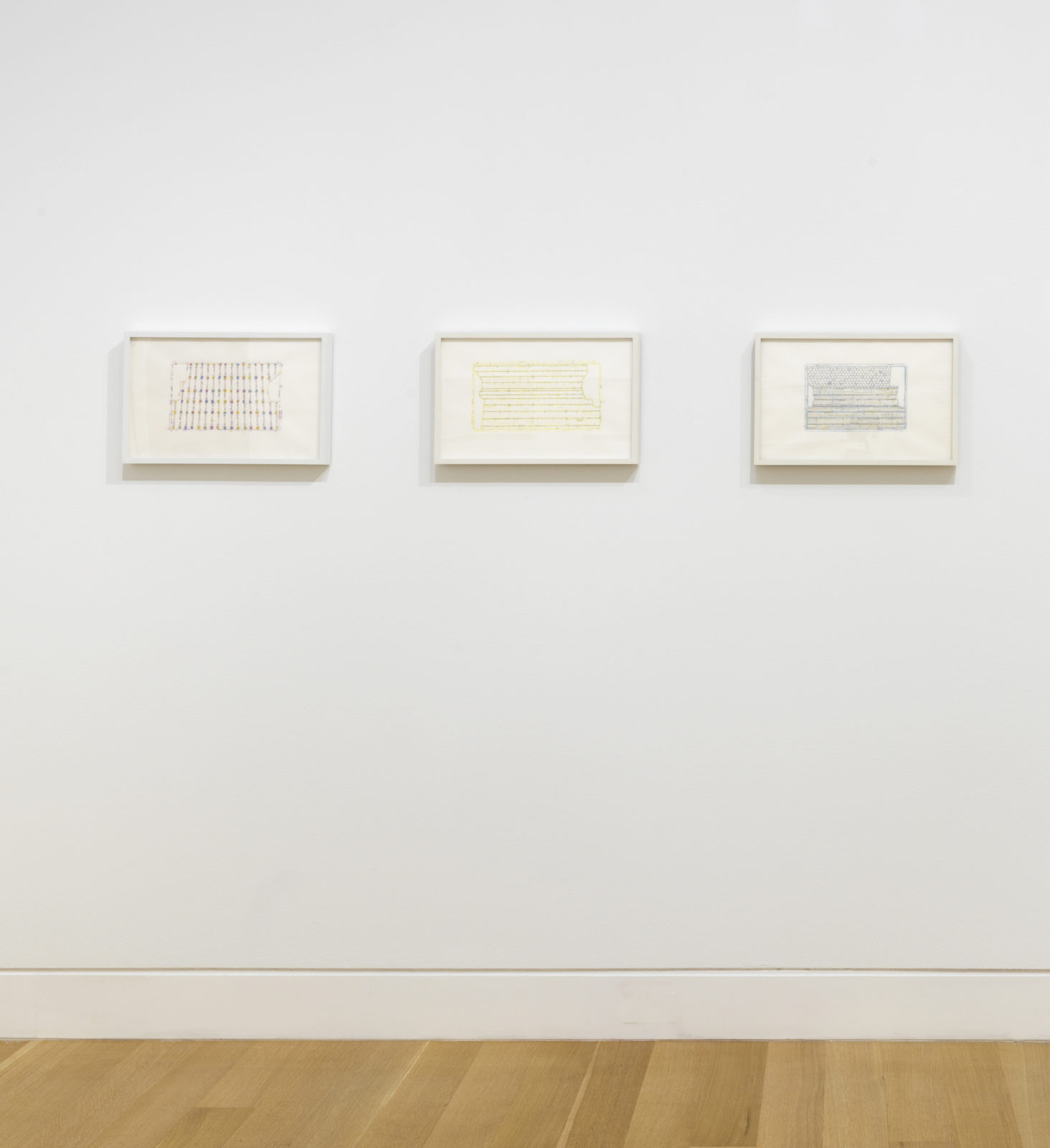
In the Matrix series, content is no longer moored to the actualities of domestic architecture, but instead summoned up in layers of paint added and removed, like the repeated motifs in a fugue. Fish revises, recombines, and even dissolves previous gestures with turpentine to reveal a residue of painted traces, such that a palimpsest remains of the six thresholds. The title of Threshold-score for six Plans: [chambered spectrum:east to west]/for ECN (2017–19) explicitly underscores the analogy to music, alternating from part to whole in three registers that connote musical staffs and notation. In this, her least referential painting, a richly textured grey negative space occupies the larger areas of the composition. At the top a border of hexagonal linear diagrams of light fixtures—dashes of lavender, lime, orange, pale blue, pink, and lemon—seem to twirl from left to right. In the exact middle, a row of six brackets, surrogates for thresholds, secure and stake out the midsection. The lowest register pictures Lego-like stacks of twelve, the six primaries and their complementary colors.
“Like those dreams that we cannot quite remember, Fish’s work conveys an aura of partial recall.”
The title Threshold-Plans:sleepwalker [spectrum stack, west to east when west is green] (2018–19) suggests that the painting’s protagonist might be the artist, or a personification of the spectrum itself, sleepwalking. Against a blackened field that obscures the underlying grid, this rakish tower of blocks of primary and secondary colors floats slightly above the edge of the canvas, the green at the base nudging upward as it overlaps violet, then red, blue, yellow, and orange. Like those dreams that we cannot quite remember, Fish’s work conveys an aura of partial recall. Here, she overturns her earlier left-to-right orientation in this vertical stack of threshold centers, allowing us to just make out faint traces of verticals lines of the preexisting grid. In the 2018 gouache Study for Threshold – Plan [las meninas][spectrum:east to west over grey], Fish’s ingenuity becomes more apparent. Downplaying her relationship to the history of representation, she references the complicated spatial organization of the eponymous masterpiece. As in a frieze, threshold forms are linked together against a muffled black ground, while linear traces that survive the repeated adjustments are barely visible.
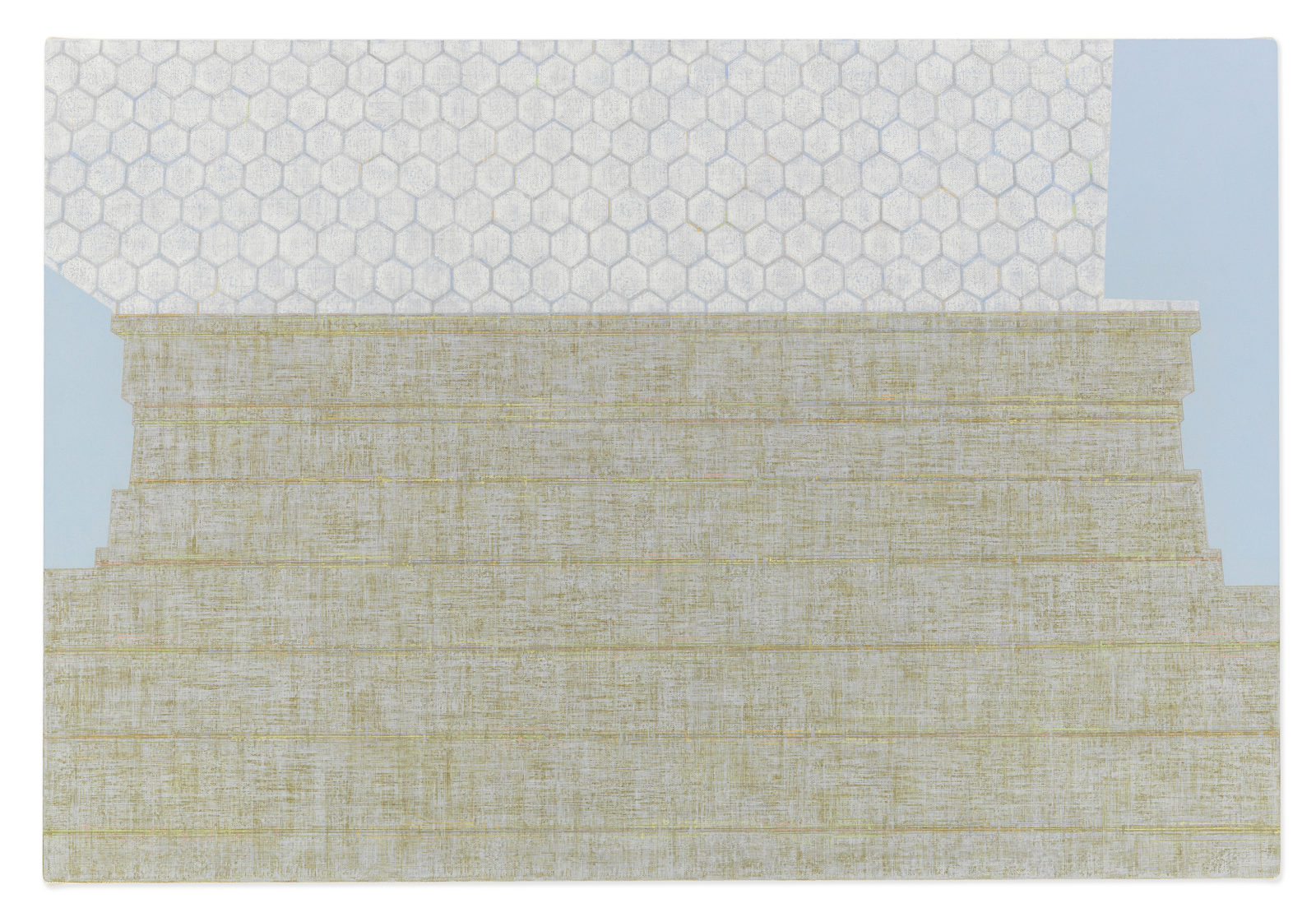
Installed in the last gallery of the exhibition were drawings including gouache studies and a series of five 11.5 x 17.5 inch drawings on UV paper made after the paintings, entitled Traces (2014–16). Fish’s exquisite draftsmanship and endless variations are revealed in this group of doorsills, with Trace 2: after Threshold, SouthEast – Two[spectrum orange with grey] (2016) reiterating the vertical floor boards in Trace 1:after Threshold, NorthWest – One[spectrum:violet and grey]. More puzzling is a group of three, titled Spectre, including Spectre:threshold, SouthWest – Two[spectrum: green] (2014), in which she compresses the constructions of earlier paintings to acknowledge the chromatic ghosts in the room. Manipulating both sides of the paper, in which horizontal lines are embedded, Fish draws with pastel and acrylic on the reverse. She then places that sheet over grey paper so that the drawing is again discernible as if it were glimpsed through a screen of white blinds. Subtle and reduced, these lines appear as schematic exoskeletons of her subject matter. Within the context of Fish’s spectral sequence, these drawings can be interpreted as paradoxical footnotes, indeed rejoinders, to the very precise rules of the representational lexicon the artist has developed.
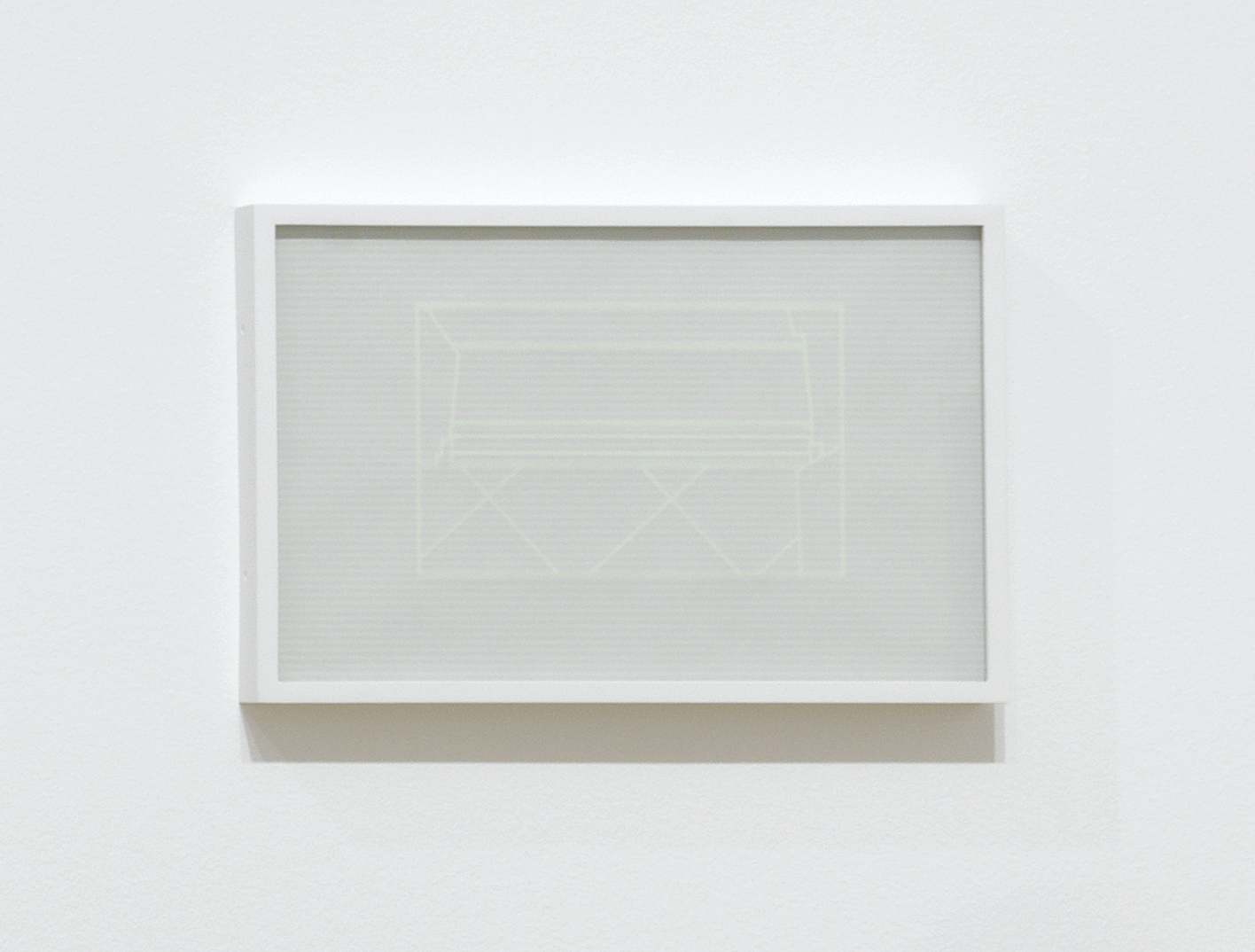
Julia Fish, Spectre : Threshold, SouthWest Two – [ spectrum : green ], 2014. Chalk pastel and acrylic on UV paper, overlaid to grey paper. 11.5 x 17.5 inches (29.21 x 44.45 cm). Courtesy Rhona Hoffman Gallery. Photo: Tom Van Eynde.
Modifications of seemingly quotidian reality, Fish’s gendered abstractions transform domestic details into idiosyncratic annotations in her signature hues. But this framework alone is insufficient to convey the layers of expressive meaning the work has accrued. Hidden in plain sight, her plans and recurring templates resist immediate comprehension—coalescing in place as shimmering traces that demonstrate the fundamental instability of perception. Her meticulous brushwork, color harmonies, and personal iconography manifest a formally stunning repudiation of the very boundaries invoked in the exhibition’s title, bound by spectrum. This presentation confirms the conceptual intricacy and optical vibrancy of Fish’s luminous oeuvre, in which the very processes of making a painting generates her artwork. Concentrating on the intervals between rooms, between floorboards, and between ideas and images, she annexes emotional meaning from fragments. Hovering between light and dark, in moments where time is seemingly suspended, Fish’s paintings give form to liminal space through images that embody the inevitable spectral return of what has been stepped over, dismantled, or forgotten.